HOUSEHOLD INCOME AND WEALTH
Household income is the major component of economic resources for most households. As such, it is a key determinant of the economic situation of households. In 2003–04, the average equivalised disposable household income of all Australians was $549 a week. This was 21% higher than in 1994–95.
In the period from 1994–95 to 2003–04, Australians have experienced a trend of rising incomes. Over this period, there was a 22% increase in the real mean incomes of both low income people and middle income people and 19% for high income people.
For low income people (represented by the 20% of people with household income between the bottom 10% and bottom 30% of incomes), average equivalised disposable household income in 2003–04 grew by 9% ($24 per week), compared to 7% for middle income people and 3% for high income people.
Income is not the only economic resource available to households. Higher levels of wealth also support higher living standards. Wealth is distributed between households somewhat differently to income, whereby a relatively small proportion of households have relatively high net worth and a large number of households have relatively lower net worth. The mean household net worth of all households in Australia in 2003–04 was $468,000, but the median (i.e. the mid-point when all households are ranked in ascending order of net worth) was substantially lower at $295,000.
The differences in the distribution of wealth and income partly reflect the common pattern of wealth being accumulated during a person's working life and then used during retirement. Therefore, many households with relatively low wealth have relatively high income, especially if the households comprise younger people.
A household’s consumption of goods and services is closely related to its economic resources. Higher levels of consumption have implications for waste generation and energy consumption among other environmental concerns.
PERCENTAGE CHANGE IN REAL EQUIVALISED DISPOSABLE HOUSEHOLD INCOME (a)
 a) Change from previous survey year. (b) Persons in the second and third income deciles after being ranked
by their equivalised disposable household income. (c) Persons in the fifth and sixth income deciles after
being ranked by their equivalised disposable household income. (d) Persons in the ninth and tenth
income deciles after being ranked by their equivalised disposable household income.
(e) No survey was conducted in 1998–99 or 2001–02
Source: Household Income and Income Distribution, Australia, 2003–04 (cat. no. 6523.0).
a) Change from previous survey year. (b) Persons in the second and third income deciles after being ranked
by their equivalised disposable household income. (c) Persons in the fifth and sixth income deciles after
being ranked by their equivalised disposable household income. (d) Persons in the ninth and tenth
income deciles after being ranked by their equivalised disposable household income.
(e) No survey was conducted in 1998–99 or 2001–02
Source: Household Income and Income Distribution, Australia, 2003–04 (cat. no. 6523.0).
 Print Page
Print Page
 Print All
Print All